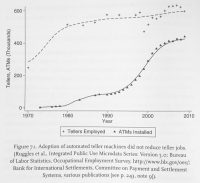If the techno-pessimists are right and robots are set to take all the jobs, shouldn’t employment in Amazon warehouses be plummeting right now? After all, Amazon’s sorting and fulfillment centers have been automated at a rapid pace, with robotic technologies now being integrated into almost every facet of the process. (Just watch the video below to see it all in action.)
And yet according to this Wall Street Journal story by Laura Stevens, Amazon is looking to immediately fill 50,000 new jobs, which would mean that its U.S. workforce “would swell to around 300,000, compared with 30,000 in 2011.” According to the article, “Nearly 40,000 of the promised jobs are full-time at the company’s fulfillment centers, including some facilities that will open in the coming months. Most of the remainder are part-time positions available at Amazon’s more than 30 sorting centers.”
How can this be? Shouldn’t the robots have eaten all those jobs by now?
The reality is that we suffer from a serious poverty of imagination when it comes to thinking about the future, and future job opportunities in particular. “One thing automation alarmists sometimes miss is that the simplistic ‘machines steal jobs’ story tells an incomplete tale,” observes James Pethokoukis of the American Enterprise Institute. “How machines can complement what humans do and create increased demand should not be overlooked when evaluating the rise of the robots. Yet it seems like it often is,” he notes.
Bank tellers are the paradigmatic example. With the rise of ATMs a few decades ago, many thought the days of bank tellers were numbered. But research by economist James Bessen of Boston University shows that we have more bank tellers today than we did 40 years ago. (See chart below). How’s that? Because once the ATMs could handle the menial tasks of counting and distributing money, the tellers were freed up to do other things.
This is a part of the story of technological change that is often ignored, as Pethokoukis suggests. Old jobs and skills are indeed often replaced by mechanization and new technological processes. But that in turn opens the door to people to take on new opportunities — often in new sectors and new firms, but sometimes even within the same industries and companies. And because human needs and wants are essentially infinite, this process just goes on and on and on as we search for new and better ways of doing things. And that’s how, in the long run, robots and automation are actually employment-enhancing rather than employment-reducing. (For a historical overview of this process, see this paper on “Does Productivity Growth Threaten Employment?” by David Autor and Anna Salomons as well as Autor’s 2015 paper, “Why Are There Still So Many Jobs? The History and Future of Workplace Automation.” Also see this McKinsey report on “Four fundamentals of workplace automation.” from 2015.)
Of course, in the short-run, that process of creative destruction isn’t always pretty. In fact, it can be gut-wrenching for some professions and workers. But the long arc of history, this is how progress happens.


 The Technology Liberation Front is the tech policy blog dedicated to keeping politicians' hands off the 'net and everything else related to technology.
The Technology Liberation Front is the tech policy blog dedicated to keeping politicians' hands off the 'net and everything else related to technology.